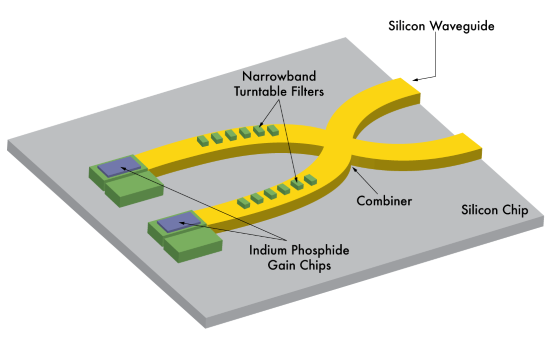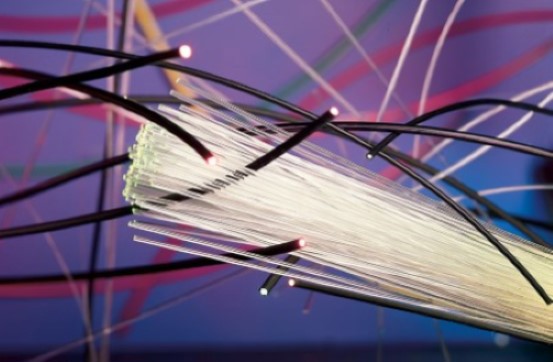

|
|
Integrated photonics use light instead of electricity for computing and signal processing |
|
|
Photonic integrated circuits are faster and more efficient than conventional circuits |
|
|
Electrons are sluggish and interfere with each other, limiting the speed of conventional circuits |
|
|
Hybrid technologies combine photonic and electrical circuits |
Integrated circuits (ICs), or microchips, are essential parts of countless modern technologies from medical devices to smart watches to spacecraft. They consist of a set of electronic components such as transistors, resistors, and amplifiers on a semiconductor wafer. Much of the functionality of these electrical components can be replaced with photonic components including laser diodes, waveguides, filters, and gain media to create photonic integrated circuits (PICs) which use light instead of electrons to function (Figure 1).
PICs offer numerous advantages over conventional circuits including higher speed, greater bandwidth, and lower energy loss. Hybrid technologies utilizing both PICs and ICs as well as purely photonic circuits are advancing technology and science past the electronics age and into the future, pushing the boundaries of what is possible for telecommunications, computing, defense, and consumer technology.

| Pros and Cons: Conventional Integrated Circuits vs. Photonic Integrated Circuits | ||
| Characteristic | Conventional Integrated Circuits | Photonic Integrated Circuits |
|---|---|---|
| Speed | Low | High |
| Bandwidth | Low | High |
| Power Efficiency | Low | High |
| Size | Small | Large |
| Availability | High | Low |
Conventional integrated circuits work by conducting electricity, or allowing electrons to flow easily through the circuit. Electrons are negatively charged subatomic particles that interact with other electrons as well as other particles. These interactions slow electrons down as they move through ICs, limit the amount of information that can be transmitted, and generate heat, which causes energy losses. A heat sink or other cooling technique is often required to regulate heat generation, otherwise the electrical components may become irreversibly damaged.
Photonic integrated circuits utilize photons, massless fundamental particles representing a quantum of light, instead of electrons. Photons move at the speed of light through the transmitting medium with almost no interference from other photons. This greatly increases the bandwidth and speed of the circuit while drastically reducing the amount of energy loss, making PICs more power efficient. With multiplexing techniques, an extremely large number of signals can be sent through a single-mode fiber that is orders of magnitude larger than the number of electrical signals that copper can transmit. A single fiber strand in a submarine transatlantic fiber optic cable can carry millions of simultaneous phone calls almost 100 km before needing amplification, and the amplifiers themselves are optically pumped lasers: no electronics involved.
However, one of the biggest drawbacks of PICs is their size. The current transistor density on ICs is about a hundred million transistors per millimeter. This makes nanometer scale ICs possible and allows personal computers, cellphones, and wearable technology to exist at their current convenient sizes. PICs, while continuing to shrink, are still only on the micron scale.
PICs are still a developing technology. Full photonic systems utilizing PICs almost exclusively with the complexity and infrastructure levels found in electronic devices like computers have yet to come to fruition. Although, some photonic-based systems are currently supplementing or replacing components in larger electronic systems to increase efficiency, rather than being used in a purely photonic system. This is analogous to how digital systems began to replace legacy analog components such as thermometers or rotary dial telephones in the second half of the 20th century before advancing into larger, more complex systems.
An example of this trend is seen in the telecommunications industry where high-speed information is transmitted along fiber optic waveguides (Figure 2). The information must ultimately be converted into digital signals for common electronic devices to process because common data networks and power infrastructures exist on electrical structures: not photonic structures. Because optical systems are more power efficient than electrical systems, PICs will likely continue replacing conventional ICs in a wide range of applications.

The development of silicon as a viable semiconductor substrate for photonic components is making the integration of PICs and ICs more feasible. PICs are typically fabricated on a variety of different and sometimes multiple layered substrates such as InP and GaAs. However, due to the ubiquity and abundance of silicon substrates for most ICs and electronics, the integration of PICs into existing devices will be much more convenient on silicon substrates. One example is the development of nanolaser diodes integrated into silicon microchips, which facilitates on-chip communications and data processing.
The silicon photonics market is projected to grow from $25 million USD in 2013 to over $700 million USD in 2024, according to a report by Yole Développement July 2014. This explosive growth would cause photonic integrated circuits to replace conventional electric circuits in a wide range of industries including data centers, high-performance computing, medical sensing, telecommunications, and consumer devices.
As the quantity of data stored and shared continues to increase, the demands on communication networks and data centers increase. Using PICs and photonic computers, data centers could handle Terabit-scale rates of data traffic, reduce power consumption by a factor of two, and reduce switching speeds and costs. One example of recent advances in photonic computing is the University of Pennsylvania’s research led by Ritesh Agarwal, into designing optical switches that function similarly to electronic transistors. By applying an electric field to a nanoscale strip of cadmium sulfide, optical signals were able to be mixed with minimal losses. The high speed, bandwidth, and efficiency of PICs could make them a crucial part of the high-speed technology of the future.
 Why are photonic integrated circuits more power efficient than conventional integrated circuits?
Why are photonic integrated circuits more power efficient than conventional integrated circuits?
 Are there any commercially available photonic integrated circuits?
Are there any commercially available photonic integrated circuits?
Yes, there are some commercially available photonic integrated circuits, but they are not widely available and are still significantly more expensive than conventional integrated circuits. As integrated photonic technology continues to develop, more accessible photonic integrated circuits will likely become available.
 Does Edmund Optics® sell photonic integrated circuits or components for PICs?
Does Edmund Optics® sell photonic integrated circuits or components for PICs?
No, Edmund Optics does not currently sell any photonic integrated circuits or components for PICs.
 What are some examples of devices that integrate photonic integrated circuits with conventional integrated circuits?
What are some examples of devices that integrate photonic integrated circuits with conventional integrated circuits?
Some examples of devices that integrate PICs with ICs are small electrically-pumped lasers including quantum cascade lasers, optical add-drop multiplexers, complementary metal–oxide–semiconductor (CMOS) sensors, and organic light emitting diodes (OLEDs).
or view regional numbers
QUOTE TOOL
enter stock numbers to begin
Copyright 2023, Edmund Optics India Private Limited, #267, Greystone Building, Second Floor, 6th Cross Rd, Binnamangala, Stage 1, Indiranagar, Bengaluru, Karnataka, India 560038
California Consumer Privacy Acts (CCPA): Do Not Sell or Share My Personal Information
California Transparency in Supply Chains Act
The FUTURE Depends On Optics®